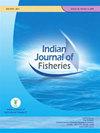Optimisation of cryovials and milt dilution ratios to upscale carp sperm cryopreservation for use in hatchery seed production
IF 0.3
4区 农林科学
Q4 FISHERIES
引用次数: 0
Abstract
This study reports the experimental results carried out to optimise containers and miltdilution ratios for carp sperm cryopreservation, in order to make the process simple andcompatible with the needs of commercial carp seed production, which is a small-scale andlow technology sector in Asia. The procedure optimisation for up-scaling was assessedby the ability of cryopreserved sperms to fertilise Cyprinsu carpio eggs and hatchingpercentage, in three different experiments. In the first experiment, we tested the effect ofmilt to different extender dilutions (1:4, 1:6 and 1:8); the second experiment tested theeffect of container capacities (0.5 ml French straw; 2 ml and 5 ml cryovials) with two dilutionratios (1:3 and 1:6) and in the third experiment, the efficacy of pre-mix of extender salts andindividually pre-weighed salts stored over 5 months was compared with fresh preparationof extender. Out of the three dilutions tested, two dilutions viz., 1:4 and 1:6, yielded hatchingabove 50%. We also used the milt cryopreserved at dilution of 1:3 which was post-thawdiluted with extender, to make final dilution of 1:6, to fertilise the eggs. This post-thawdilution in the ratio 1:6, yielded the results comparable to the milt cryopreserved in 1:6dilution. This approach can help small-scale seed producers to store more sperm withinthe limits of the cost of liquid nitrogen. The extender salt composition, pre-weighed andpre-mixed, was also found to give comparable results to the fresh composition after storageover 5 months. This can assist in developing ready to use, cost-effective, working kitsavailable to semi-technical hatchery seed producers. The parameters optimised in the studyhas potential to be transformed as an easy strategy with the use of 5 ml vial, cryopreservedat 1:3 dilution, with further post-thaw dilution at site, thus aiding in fertilisation of largevolume of eggs produced by high fecund carp species within the limited time available formaintaining good gamete quality. Keywords:Cryobanking, Cryovials, Dilution, Salt premix优化低温瓶和幼体稀释比例,将鲤鱼精子低温保存用于孵化场种子生产
本研究报告了为优化鲤鱼精子冷冻保存的容器和稀释比例而进行的实验结果,目的是使这一过程变得简单,并符合商业鲤鱼种子生产的需要,在亚洲,商业鲤鱼种子生产是一个规模小、技术含量低的行业。在三个不同的实验中,我们通过冷冻保存的精子使鲤鱼卵受精的能力和孵化率评估了扩大规模的程序优化。在第一项实验中,我们测试了不同稀释度(1:4、1:6 和 1:8)的扩展剂对精子质量的影响;第二项实验测试了两种稀释度(1:3 和 1:6)的容器容量(0.5 毫升法国吸管、2 毫升和 5 毫升冷冻瓶)的影响;第三项实验比较了储存 5 个月的扩展剂盐预混物和单独预称重盐与新鲜扩展剂的功效。在测试的三种稀释液中,1:4 和 1:6 两种稀释液的孵化率超过 50%。我们还使用了以 1:3 稀释度冷冻保存的蝌蚪,并在解冻后用扩展剂稀释成 1:6 的最终稀释度,使蝌蚪卵受精。按 1:6 的比例进行解冻后稀释,结果与按 1:6 稀释度冷冻保存的粟米相当。这种方法可以帮助小型种子生产商在液氮成本允许的范围内储存更多精子。研究还发现,经过预称重和预混合的扩展盐成分在储存 5 个月后的结果与新鲜成分相当。这有助于为半技术孵化种子生产商开发即用型、高成本效益的工作试剂盒。该研究中优化的参数有可能转化为一种简便的策略,即使用 5 毫升小瓶,以 1:3 的稀释比例冷冻保存,并在现场进行进一步的解冻后稀释,从而在有限的时间内帮助高繁殖力鲤科鱼种产生的大量卵子受精,以保持良好的配子质量。关键词:冷冻库 冷冻瓶 稀释 盐预混料
本文章由计算机程序翻译,如有差异,请以英文原文为准。
求助全文
约1分钟内获得全文
求助全文
来源期刊

Indian Journal of Fisheries
FISHERIES-
CiteScore
0.90
自引率
20.00%
发文量
0
审稿时长
6-12 weeks
期刊介绍:
Indian Journal of Fisheries is published quarterly by the Indian Council of Agricultural Research (ICAR), New Delhi. Original contributions in the field of Fish and fisheries science are considered for publication in the Journal. The material submitted must be unpublished and not under consideration for publication elsewhere.
Papers based on research which kills or damages any species, regarded as thratened/ endangered by IUCN crieteria or is as such listed in the Red Data Book appropriate to the geographic area concerned, will not be accepted by the Journal, unless the work has clear conservation objectives.
 求助内容:
求助内容: 应助结果提醒方式:
应助结果提醒方式:


